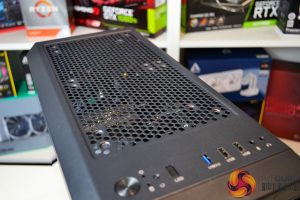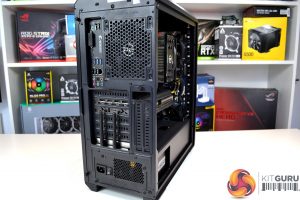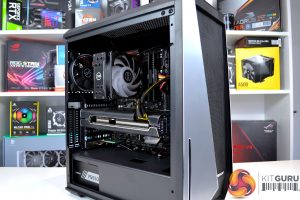PCSpecialist Ignite X1 Gaming PC
Looking from the outside with the system powered off, the Ignite X1 appears as though it could be just your run of the mill basic office type system, with its rather understated appearance. It's not until you turn the system on and see the RGB lighting from the three 120mm fans at the front that you realise it has some gaming pedigree.
The chassis used in the Ignite X1 is labelled as PCSpecialist own Wraith RGB mid-tower. Its quite a compact design and comes with a mildly tinted tempered glass side panel so you can see the internal components and should provide good airflow with the large, unrestrictive mesh front panel.
Along the top of the front panel are the front I/O ports which consist of a single USB 3.0 Type-A port, two USB 2.0 Type-A ports, 3.5mm HD Audio jacks, power/reset buttons and an LED button to scroll through various RGB lighting colours and patterns.
Right behind the I/O ports on the top of the case is a large, fine mesh dust filter. This can be removed if necessary and leaves behind a more open mesh top section that will allow extra heat to dissipate from the system while also providing access to the screw in points for top fan mounting.
Around the back of the case are the usual seven PCIe expansion slots, typical of mid-tower cases. At the top of the PCIe expansion slots is the graphics card with three DisplayPort sockets and a single HDMI port where you can connect up your monitors. There is also the two antennas from the Wi-Fi card and above are additional motherboard I/O ports such as USB 3.0/2.0 ports and 3.5mm HD Audio jacks.
On the underside of the chassis are four feet that raise the system up enough to allow good airflow to the power supply unit. There is also a fine mesh dust filter covering the power supply fan vent that can be easily removed for cleaning.
There has been thought put into component selection, not only in terms of matching performance but in appearance too. All the major parts of the system have a black and silver theme, with the exception of the Wi-Fi card with its green PCB that looks slightly out of place.
The overall build quality looks good, there has certainly been some care taken during assembly, all the components that make up the system seem to have been fitted well and there is attention to detail, with neat cable management and all matching case fans, three at the front and one in the rear. The only slight gripe is the graphics card sag, however, this is difficult to avoid with modern heavy graphics cards.
Around the boring side of the system, behind the motherboard tray looks very neat and tidy, cables have been bundled together, tied down to the cable management eyelets and hidden away under the power supply shroud, something that is often overlooked by some OEM system builders.
Something we touched on earlier is the fact that an 80 Plus White power supply has been used in the system, possibly to keep the cost down. Not only does this reduce power efficiency of the system compared with an 80 Plus Gold unit, it affects the aesthetics a little too with the multi-coloured cables, although it should not affect performance which is what we care about most.
 KitGuru KitGuru.net – Tech News | Hardware News | Hardware Reviews | IOS | Mobile | Gaming | Graphics Cards
KitGuru KitGuru.net – Tech News | Hardware News | Hardware Reviews | IOS | Mobile | Gaming | Graphics Cards




















